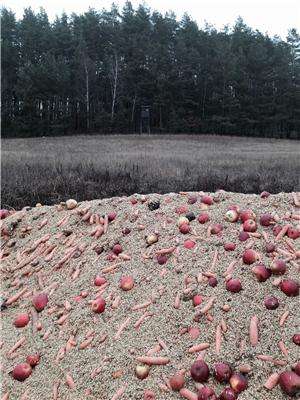Deer feeding puts birds at risk

By comparing the fate of artificial nests close and far away from supplementary feeding sites located in the forest for ungulates, such as deer and wild boar, researchers found that those nests in the vicinity of feeding sites were depredated twice more. This "predation hotspot" effect extends far away from the feeding site itself: in a radius of 1-km the probability of nest survival is lowered. When accounting for all feeding sites in the study region (ca 2000 km2), this would mean that in one fifth of the area ground-nesting birds will have little chance to see their eggs hatching. These sites attract not only deer and wild boar- the boar is also a nest predator-, but also corvids, rodents, bears and other species of nest predators, which are not the target of feeding. Therefore, this management practice, widespread in central Europe, comes into conflict with the conservation of ground-nesting birds, such as grouse species, which are declining worldwide.
The study was conducted by researchers of the Institute of Nature Conservation of the Polish Academy of Sciences in the Carpathian Mountains, where this practice is deeply-rooted and increasing. "Hundreds of tons of food are thrown every year in the forest, without thinking on the collateral effects and potential consequences", said Nuria Selva, leader of a project funded by the National Science Centre to investigate the ecological effects of supplementary feeding. The study recommends to avoid ungulate feeding in the breeding areas of bird species of conservation concern, such as capercaillie or black grouse, and to stop feeding before the bird nesting season starts. "We urge for sensible feeding practices and for taking a wider ecosystem perspective, rather than focusing on single issues or species" said Teresa Berezowska-Cnota, co-author of the study.
"All our actions in the environment have some effects, and providing food is not an exception. The spread of diseases, for instance, is one of the reasons why deer feeding has been banned in many regions of North America. While supplementary feeding of wildlife is becoming increasingly common in conservation, management and ecotourism, ourunderstanding of the complex effects of providing artificial food to wildlife is still limited", commented Selva. The study is published today in PLOS ONE.
More information: Selva N, Berezowska-Cnota T, Elguero-Claramunt I (2014) Unforeseen Effects of Supplementary Feeding: Ungulate Baiting Sites as Hotspots for Ground-Nest Predation. PLoS ONE 9(3): e90740. DOI: 10.1371/journal.pone.0090740
Journal information: PLoS ONE
Provided by Polish Academy of Sciences


















